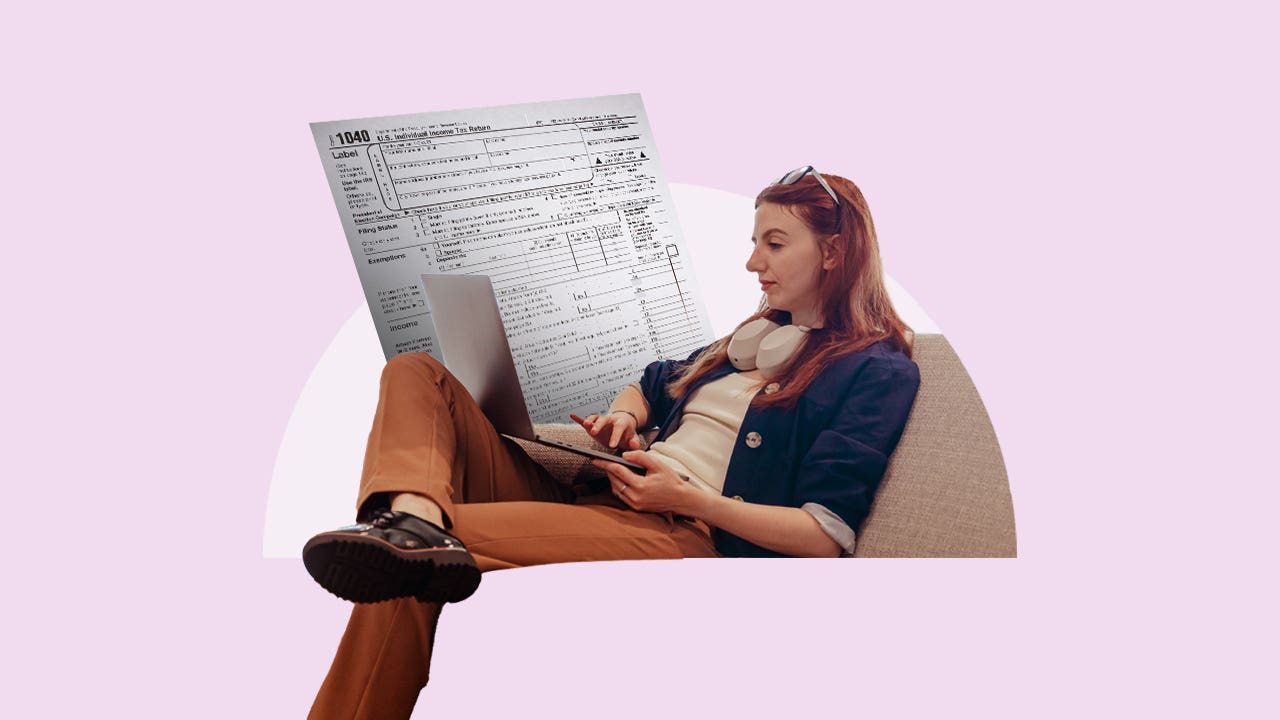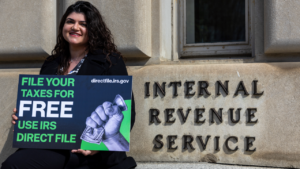How to file taxes for the first time: Everything you need to know

I remember doing my taxes for the first time. I was 22 and received a bunch of 1099s for doing some background work as an actor. Suddenly those fun jobs didn’t seem that fun anymore. The forms were intimidating, and I didn’t have the slightest idea what I was supposed to do with them. “Filing taxes” was a vague concept to me at the time.
Eleven years later, I’m pretty confident doing my taxes. I can’t say I enjoy it (and who does?), but at least I know what’s going on.
If you’re here, you’re probably doing online research on this scary topic. Welcome, make yourself comfortable and let’s talk about how to do your taxes for the first time.
Do you need to file this year?
First things first, let’s figure out if you even need to file. This will depend on your income, age and filing status. For instance, if you’re not married, younger than 65 and your gross income was less than $14,600 in 2024, you don’t need to file this year. On the other hand, if that income was from self-employment, and you made more than $400 in net earnings, you’d be required to file a tax return.
Not sure if you need to file? The IRS has a convenient tool to help you determine that. Just answer a few simple questions. In some cases, you may not be required to file, but if you’re eligible for a tax refund you’d need to file in order to get your money back.
What do you need to file your taxes?
If you need to file, you’re going to need to gather your tax forms. They may include:
Income tax forms
The tax forms you need to file your taxes include W-2s, 1099s and other forms reporting any kind of income. Remember that the IRS wants to know about all of your income, including your side gigs, bonuses and interest income (such as from your high-yield savings account, which will send you a 1099-INT form if you’ve earned more than $10 in interest). For instance, I get 1099-INTs every year from Capital One, Discover and the credit union I’m a member of because that’s where I keep my savings.
Deductions and credits
Tax deductions and tax credits are a good thing: They can lower your tax bill and add to your refund. For example, if you’re a student, you may be eligible for tax credits like the American Opportunity Tax Credit. Your school will notify you of qualifying costs by sending you a Form 1098-T. You also may be able to deduct interest you paid on your student loan. (In case you’re wondering, here’s the difference between tax credits and tax deductions.)
The student loan deduction is one of a handful of deductions that doesn’t require you to itemize — “itemize” basically means just adding up your deductible expenses. However, you have to choose between itemizing and claiming the standard deduction, and usually claiming the standard deduction makes the most sense. The standard deduction is a flat amount the IRS allows you to subtract from your income (the alternative is adding up all of your deductible expenses).
The standard deduction amount typically changes every year to account for inflation. For example, this year, if you’re single or married filing separately, you can deduct $14,600 — that’s how much you can reduce your income by before calculating your tax bill.
To make sure you’re deducting as much as you can — and that should be your goal, just keep your deductions honest — sum up your itemized deductions and see if they’ll turn out to be more than the standard deduction. If not, don’t itemize, because the standard deduction will save you more money.
Note that if you’re itemizing deductions, you need to be able to prove your expenses. This means being organized and keeping receipts so you can prove to the IRS your return is truthful.
See if you can be claimed as a dependent
Last but not the least, talk to your parents to see if they’re claiming you as a dependent on their taxes this year. This can be the case if you still live with them or they offer substantial financial help. You may still have to file your taxes, but your parents will get certain tax benefits. Additionally, when you file you’ll need to indicate that you may be claimed as a dependent on someone else’s return.
How to file your taxes
Doing your taxes boils down to adding up your income, totaling your deductions and credits to reduce your taxable income, figuring out your total tax on that income — and then hoping what you paid in taxes over the year outweighs your tax bill so the government pays you (and not the other way around). Now it’s time to file. This year, you have until April 15.
But what exactly is the process for filing your taxes? There are a few options.
Filing online
The most popular way to do your taxes is to file online. With services like TurboTax and H&R Block, you can file for free if your tax situation is simple, or pay for one of the premium packages to get access to extra features and help from tax specialists.
Using these tools is easy. They guide the process by asking you simple questions and filling out your state and federal returns for you. You can even take pictures of your tax forms and upload them to have your info entered automatically. (Here are Bankrate’s top picks for best tax software.)
Once you’re done, the tool will calculate the maximum possible refund and file your taxes for you. See, it’s not that scary!
Plus, there are five ways to file for free in 2025.
Filing with a tax pro
Last year, my taxes became more complicated. I bought my first home in 2023 and wanted to claim all the tax benefits I could.
I took a stab at filing online for free but ended up with many questions and a migraine. So, I just let someone who knows what they’re doing handle it for me. I made an appointment with a tax professional.
There’s nothing wrong with having a specialist do your taxes if your tax situation is a bit more complex. Of course, you’ll have to pay a fee, which varies by the tax preparer and complexity of your taxes. It can be a certified public accountant, attorney or enrolled agent — just make sure the person is qualified by checking their credentials. Here are five tips to find the best tax preparer for you.
If you’re looking for an affordable option, look into your local credit unions which may offer low-cost tax preparation services.
If you’re still a student, you may be able to get free help on campus. The IRS has a database of Volunteer Income Tax Assistance (VITA) sites that you may be able to use, and many are located on college campuses.
Filing your taxes by hand
I’ve never met anyone who’s still doing their taxes manually, especially when it’s their first time. You’d have to fill out Form 1040 by hand and use a calculator to add up all your income and deductions. Then you’d have to mail the form and wait at least four weeks for the IRS to process your return. Here’s more on how long it takes to get your tax refund.
To be completely honest, I don’t see a reason for anyone to choose this route. When there are services that allow you to file online for free, why would you go so old-school?
How to pay your taxes
Now to the not-so-fun part.
Often, you can expect a tax refund (meaning you overpaid in taxes and the IRS will return the money it owes you). But sometimes that’s not the case, and you’re required to pay your share.
There are a few ways you can do so.
Paying with your bank account
This is your best option because this way you’ll avoid any fees. Plus, the IRS will have your account information on file for refunds. People who pay directly from their bank account can count on the quickest process — and the fastest refund if they’re owed one.
Paying with a card
You can also pay your taxes with a debit or credit card, but keep in mind that there will be fees involved.
If you ask me, it doesn’t really make sense to pay with your debit card — just use your bank account instead to avoid the processing fee and get all the benefits that come with the direct deposit.
As for whether it’s a good idea to pay with a credit card, it depends. There’s also a fee, but if you’re working toward earning your sign-up bonus, it may be worth it.
I know some hardcore credit card enthusiasts who once overpaid their taxes to get a bonus, knowing the IRS would refund them. Do the math to see if that makes sense in your case and make sure you can pay off the debt right away to avoid losing money to your card’s interest (unless you have a 0 percent APR credit card).
Apply for a payment plan
What if your tax burden is too big for you to pay?
At my first writing job, I was considered an independent contractor even though I worked a regular schedule. That meant I was technically self-employed for tax purposes and received a 1099. Even after all the deductions, the taxes I owed still made me want to cry. There was no way I could afford to pay that sum outright.
Thankfully, the IRS offers various payment plan options. Like with any kind of debt, there’s interest to pay on top of penalties. But in a pinch, a payment plan can be very helpful. Here are your options if you can’t pay the IRS.
The IRS offers solutions for other situations too, including when you don’t have a bank account or if your financial situation is really dire. For more details, here are nine ways to pay your taxes.
Bottom line
Taxes are never fun. Still, don’t let the process scare you, even if you’re filing for the first time. Use a reliable tax service or contact a tax professional if you could use some help — just make sure to check their credentials. You can do it, and welcome to the wonderland of adulthood.
Why we ask for feedback Your feedback helps us improve our content and services. It takes less than a minute to complete.
Your responses are anonymous and will only be used for improving our website.






